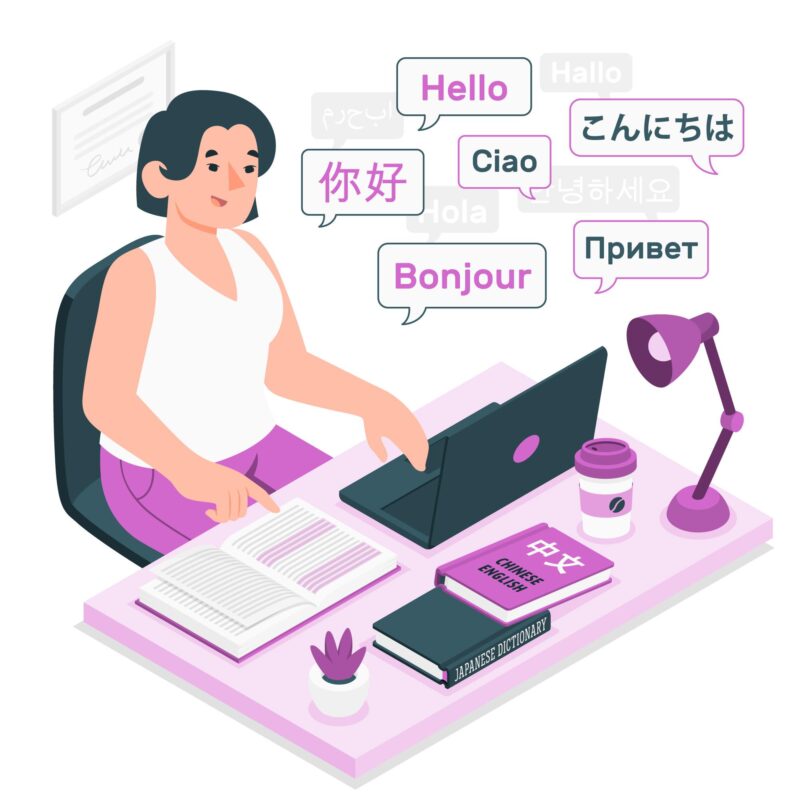Introduction:
In the ever-evolving landscape of language translation, a remarkable paradigm shift is underway, driven by the revolutionary power of Generative AI. The future of language translation with Generative AI services heralds a transformative communication and global connectivity era.
With the ability to comprehend and generate human-like text in multiple languages, Generative AI is rewriting the rules of linguistic interpretation. This technological marvel promises enhanced accuracy, efficiency, and cultural sensitivity, paving the way for seamless cross-cultural communication.
Join us on a journey through this groundbreaking development as we delve into the intricacies and potentials of Generative AI services in shaping the future of language translation.
Generative AI: The Language Translation Revolution
Shaping Natural Language Communication
Generative AI services have fundamentally altered how humans communicate between languages in the field of language translation. AI-enhanced language translation has opened up new possibilities by bringing unmatched naturalness and efficiency to multilingual communication.
AI translation can produce more human translations because of its capacity to comprehend context, colloquial idioms, and cultural nuances. The stiff, uncomfortable sentences of the past have been replaced by natural, context-sensitive translations that smoothly span linguistic barriers.
It’s important to consider the ethical implications as we examine these new trends in multilingual communication. Ethical considerations in AI language translation include protecting privacy, preventing bias, and maintaining cultural authenticity.
Language translation is changing in this era of lightning-fast technology development, becoming more than just a tool but also a bridge that promotes true cross-cultural understanding.
Emerging Trends in Multilingual Communication
Generative AI is at the forefront of revolutionary change, delving into the Emerging Trends in Multilingual Communication.
The way we communicate across languages is changing because of this cutting-edge technology, which also provides several advantages that were long thought of as science fiction.
Communication is becoming increasingly complex and human-like due to generative AI’s capacity to understand context and cultural nuances. By offering natural-feeling real-time Advanced Translation Technology, it is dismantling language barriers.
Voice recognition and synthesis are also rapidly included in AI-powered translation systems, allowing for seamless spoken communication in various languages.
Additionally, Generative AI is speeding up and lowering the cost of the localization process for enterprises. It enables the accurate, automatic creation of multilingual text for websites and marketing materials.
Furthermore, these developments are influencing education in the future by improving the accessibility and interest of language acquisition. Personalized learning experiences are starting to become the standard with AI-driven language instructors.
Generative AI is catapulting Multilingual Communication in the AI Era of extraordinary ease and sophistication, boosting international understanding and collaboration like never before.
Real-Time Translation Advancements
- Real-time translation is made possible by generative AI, allowing for instantaneous linguistic communication.
- It understands cultural nuances, idiomatic idioms, and context to produce more precise and accurate translations.
- This development is promoting more seamless cross-cultural contact and removing language barriers.
- Smooth cross-cultural encounters are advantageous for companies, tourists, and people.
- The globe is becoming more interconnected than ever because of technology’s ability to give real-time translations, increasing international cooperation, education, and cultural exchange.
Industry Applications and Ethical Considerations
Multilingual Communication Across Industries
Multilingual communication is being transformed by using Generative AI services in numerous businesses. Language limitations were formerly a major impediment to communication, but this game-changing technology enables frictionless connections in various fields.
AI-Enhanced Language Translation Across Industries:
- Global Business: Generative AI enables businesses to engage with clients and partners worldwide easily. Real-time translation of meetings, emails, and documents makes it possible for easier international interactions.
- Travel and tourism: AI-driven translation apps enhance the travel sector by making it simpler for visitors to navigate exotic locations and interact with locals, improving their entire experience.
- E-commerce: By offering product information and customer support in various languages, e-commerce platforms can access a wider market.
Ethical Dimensions of AI in Translation
While the benefits of AI translation are substantial, ethical considerations are paramount:
1. Privacy Concerns: AI-driven language translation often involves the processing of sensitive information, such as personal communications, medical records, or legal documents. Safeguarding this data is paramount.
Robust encryption, data anonymization, and adherence to data protection regulations are crucial to ensure the secure handling of such information.
Privacy concerns also extend to the potential for data breaches, underscoring the importance of implementing stringent security measures in AI translation systems.
2. Bias and Cultural Sensitivity: The risk of bias in AI translation arises from the data used to train these systems, which may contain cultural, gender, or other biases in the source data.
Continuous monitoring, feedback loops, and diverse training datasets are essential to mitigate this. Ethical AI development also necessitates algorithms that respect cultural nuances, avoiding offensive or insensitive translations.
Addressing these challenges ensures that AI translation is inclusive, respectful, and aligns with societal values.
3. Quality Control: Maintaining translation quality is pivotal in avoiding misinformation or misunderstandings, which can significantly affect healthcare, legal, or business communication.
Quality control mechanisms include:
- Human translators’ post-editing.
- Regular AI model updates.
- Ongoing training to keep the translation output accurate and contextually relevant.
Ensuring that AI translation systems prioritize quality control is vital for building user trust and fostering successful cross-lingual communication.
Bridging Language Barriers in Healthcare
Generative AI plays a pivotal role in healthcare by breaking down language barriers and ensuring accurate communication between medical professionals and patients from diverse linguistic backgrounds. It provides:
- Real-time Interpretation: AI-powered language translation services enable healthcare providers to communicate with patients effectively, offering timely diagnoses and treatment options.
- Medical Documentation: Generative AI aids in translating medical records and reports, enhancing patient care and research efforts.
Ultimately, Generative AI is transforming multilingual communication across businesses, making it more effective and available. Ethics must be considered as this technology develops because it bridges linguistic gaps in healthcare and eventually enhances patient care and results.
Real-World Applications and Challenges
Success Stories: AI in Language Translation
A: Facebook Translate:
Facebook uses powerful artificial intelligence (AI), such as Generative AI, to power its automatic translation services, enabling frictionless communication between people who utilize the platform and speak different languages.
This technological innovation is crucial for crossing linguistic barriers and increasing global communication.
Facebook’s AI algorithms automatically identify the language of posts and comments when they are in another language and provide translations, allowing users to comprehend the content better and increase engagement among various communities.
By removing language barriers and fostering cross-cultural relationships, it improves user experiences. Additionally, Facebook’s translation features support the platform’s goal of global connectivity.
Ensuring that their material is accessible and understandable to a wide range of users, regardless of their original languages, not only helps individual users but also benefits businesses and organizations looking to reach a worldwide audience.
Facebook’s translation services exemplify how technology may bring people together across boundaries through language as AI and Generative AI develop.
B. DeepL:
For its outstanding machine translation quality, DeepL has established a well-deserved reputation. Generative AI and neural networks, which allow for the supply of amazingly precise and natural-sounding translations, lie at the core of its success.
DeepL’s translation service is excellent at catching the subtleties of language, whether in text, documents, or web content.
The outcomes are accurate, human-like and fluent translations. Its popularity is due to its ability to go beyond literal translation restrictions and provide natural-sounding translations that appeal to native speakers.
DeepL stands out as a major participant in the rapidly developing field of AI-powered language translation thanks to its commitment to linguistic perfection.
Overcoming Implementation Hurdles
Implementing Generative AI services for language translation in organizations can be immensely beneficial, but it also comes with its set of challenges:
- Data Quality and Quantity: High-quality training data is crucial for Generative AI, and many organizations may need more bilingual data for accurate translation models.
- Customization: Tailoring the AI to specific industry jargon or unique organizational language can be complex, requiring domain-specific expertise.
- Cost: Developing and maintaining Generative AI systems can be costly due to the need for substantial computational resources and specialized talent.
- Ethical Concerns: Ensuring that AI translations are unbiased, respectful of cultural sensitivities, and maintaining privacy can be challenging.
- User Adoption: Staff may resist adopting AI-driven tools, fearing job displacement or mistrusting AI’s accuracy.
- Integration: Integrating AI translation into existing workflows, applications, or platforms can be technically challenging and time-consuming.
- Scalability: As organizations grow, scaling AI translation to handle increasing volumes of content can be tricky without additional investments.
- Regulatory Compliance: Navigating data privacy laws and ensuring compliance with international regulations can be complex globally.
Addressing these challenges requires careful planning, investment, and a commitment to ethical and responsible AI deployment.
Organizations must prioritize data quality, continuous training, user education, and collaboration between AI specialists and domain experts to reap the full benefits of Generative AI for language translation.
Measuring Impact and Future Visions
ROI in AI-Language Translation
For businesses looking to evaluate the worth and efficacy of their language communication projects, calculating the return on investment (ROI) of generative AI in language translation is essential. The following is how businesses can accomplish it:
- Cost savings: Compare translation cost savings to those of more conventional techniques. Add the cost savings from using AI-powered tools and less labor.
- Time Savings: Calculate the time that was saved by translating the information. Find out how AI shortens the time between content localization and publication.
- Quality Improvement: Assess the quality of translations. Examine accuracy, fluency, and the ability to maintain consistency in messaging across languages.
- Content Reach: Gauge the expansion of your content reach. Analyze how AI-driven translation helps in targeting diverse global audiences effectively.
- User Satisfaction: Survey user feedback and satisfaction with translated content. AI should improve user experiences through natural and context-aware translations.
By measuring these elements, organizations may fully comprehend the ROI of generative AI in language translation. In the AI era, this data-driven method aids investment justification, strategy improvement, and ongoing multilingual communication improvement.
Envisioning AI’s Role in Multilingual Education
AI has the potential to disrupt multilingual education completely, opening up new options that could have a significant impact on how students learn and use educational resources. In particular, AI-enhanced language translation is essential to this shift.
Students can easily access educational information and materials in their native languages thanks to AI-driven language translation. By successfully removing language barriers, this groundbreaking technology makes learning more inclusive and available globally to a wider range of learners.
Removing the language proficiency barrier enables students to interact with instructional information in ways that are appropriate for their level of linguistic comfort and comprehension.
In addition to empowering students, this improvement in multilingual education also promotes a richer and more individualized learning environment. It supports consumer engagement and understanding by catering to students’ unique requirements and interests.
However, it is essential to address ethical issues when the educational landscape changes due to the incorporation of AI. Ensuring that AI-driven education respects cultural sensibilities and upholds privacy is crucial. This includes considering and incorporating various cultural backgrounds and preferences in educational procedures and AI-supported content.
As AI technology develops, its use in international communication and education is expected to increase. This holds out the prospect of a more interconnected and diverse global learning environment in which students from all over the world can engage in a common educational journey facilitated by AI and where knowledge knows no linguistic bounds.
Advancements in AI Translation Hardware
Hardware advancements have played a pivotal role in enhancing the capabilities of AI in the field of language translation. These developments have been instrumental in improving the speed, efficiency, and overall performance of AI-powered language translation systems.
- Processing Power: One of the most significant contributions of hardware advancement is the increase in processing power. Powerful GPUs (Graphics Processing Units) and TPUs (Tensor Processing Units) have accelerated AI model training and inference processes. This allows translation models to process vast amounts of data quickly, leading to faster and more accurate translations.
- Memory and Storage: Enhanced memory and storage capabilities have enabled AI systems to store and retrieve extensive language datasets more efficiently. This ensures that translation models can access a broader range of language patterns and nuances, resulting in more context-aware translations.
- Parallel Processing: Hardware advancements have facilitated parallel processing, enabling Generative AI models to perform multiple tasks simultaneously. In language translation, the system can analyze source text, generate translations, and refine results in parallel, greatly reducing latency and improving real-time translation capabilities.
- Energy Efficiency: Developing energy-efficient hardware components has made AI translation more accessible and sustainable. Reduced energy consumption means that AI can be deployed on a broader scale, including mobile devices, making multilingual communication more convenient.
- Edge Computing: Edge computing devices, equipped with specialized hardware, allow AI translation to occur locally on devices rather than relying solely on cloud-based solutions. This enhances privacy and reduces the need for a constant internet connection, making translation services available in remote or offline environments.
Well, hardware advancements have significantly complemented AI in enhancing language translation. The combination of increased processing power, improved memory and storage, parallel processing capabilities, energy efficiency, and edge computing solutions has transformed the field of language translation.
As these hardware innovations evolve, we can expect even more efficient and accurate AI-powered translation services that facilitate global communication and understanding.
Conclusion:
The future of language translation, empowered by Generative AI, promises to be a transformative journey marked by several key takeaways:
- Enhanced Naturalness: Generative AI brings a new level of naturalness to language translation, enabling translations that sound more human and contextually relevant, bridging the gap between languages.
- Global Accessibility: With Generative AI, language barriers become less formidable. It fosters global connectivity by making multilingual communication more accessible, opening up new opportunities for collaboration and understanding.
- Efficiency and Speed: Generative AI accelerates the translation process, providing real-time and accurate translations, particularly beneficial for businesses, travelers, and individuals seeking instant linguistic support.
- Ethical Considerations: As Generative AI gains prominence, ethical concerns around privacy, bias, and cultural sensitivity must be addressed to ensure responsible and respectful language translation.
- Versatility: Beyond just translation, Generative AI has the potential to impact various industries, from education to healthcare, by offering customized solutions that cater to specific needs and preferences.
- Quality Control: Ensuring translation quality remains paramount, and the future of AI-powered language translation will involve continuous improvement through human oversight and feedback loops.
In conclusion, Generative AI is set to reshape the future of language translation by making it more natural, efficient, and accessible. While the technology holds immense promise, ethical considerations, quality control, and adaptability will play critical roles in realizing its full potential.
FAQs:
How does Generative AI impact the future of language translation?
Generative AI revolutionizes language translation by providing accurate, natural, context-aware translations, transforming global communication.
What are the key trends shaping AI-powered language communication?
Key trends include context-aware translations, real-time multilingual communication, and AI-driven customization for specific industries.
Are there ethical concerns when using AI for language translation?
Ethical considerations when using AI for language translation include privacy, bias, and cultural sensitivity. Therefore, responsible AI development is required.
What are the real-world applications of AI-enhanced language translation?
Real-world applications range from improving cross-cultural business communication to aiding healthcare providers in communicating with patients in diverse languages.
How can organizations measure the success of AI in language translation?
Aspects like cost savings, time efficiency, translation quality, customer satisfaction, and business growth can judge success in applying AI to language translation.










